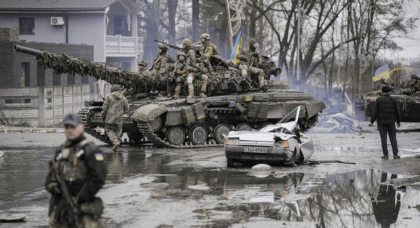Russia invaded Ukraine on February 24, 2022, with about 142,000 troops. It wasn’t large enough to fully take over the country—but big enough to force Ukraine to the bargaining table. That, Russian President Vladimir Putin explained, was always the intention: “The troops were there to push the Ukrainian side to negotiations.”
And it almost worked.
Weeks before, negotiations in Istanbul were close to sealing a deal. Instead of achieving a diplomatic end to hostilities, though, Ukraine was encouraged—some say pressured—by the U.S., the UK, Poland, and other Western NATO members to abandon that path and continue fighting. It was not until those negotiations collapsed that Russia began mobilizing additional troops and stepping up its military advance.
As historian Alexander Hill puts it in The Routledge Handbook of Soviet and Russian Military Studies, Russia’s early fiascos were at least partially due to failing to deploy its finest equipment or sheer muscle. Ironically, in the beginning, Ukraine actually had a technology edge, equipped with state-of-the-art Western hardware and intel support from NATO.
But Russia adapted. It adapted its tactics, upgraded its equipment, and discovered how to defeat even the most sophisticated Western equipment.
Flash forward three years—and the globe is a significantly different place. Ukraine’s much-hyped counterattack failed. Russia, formerly perceived as limping, is now commanding the battlefield and more advantageous at the negotiating table than it was in 2022.
If peace had been negotiated in Istanbul then, Ukraine might have come out with much less damage—perhaps even holding onto most of its territory, with the exception of Crimea. But now, with hundreds of thousands of Ukrainian soldiers killed or wounded, the war is finally going full circle to where it could have ended in the first place: the negotiating table.
And unfortunately, a lot of the major phrases on the bargaining table today aren’t that far off from those debated decades ago.
Actually, U.S. special envoy to the Middle East Steve Witkoff recently made it clear the Istanbul Protocol Agreement took the two “very, very close” to putting something down on paper. He went so far as to suggest that the same platform will most probably frame the recent ceasefire talks.
So just what was it all for?Ceasefire Declared – But Did Ukrainians D1e in Vain?
It’s becoming clear that Ukraine is not going to get all its lost territory back. It’s not going to become a NATO member, either. Even U.S. Defense Secretary Pete Hegseth has made public remarks that regaining all of Ukraine’s territory is an “illusionary goal,” and that a genuine peace will require “territorial concessions.” President Donald Trump has recently made the same remarks, saying this fall’s negotiations with Putin will be about negotiating to divide assets like land and power plants.
Most importantly, NATO Secretary General Mark Rutte confirmed that Trump had already excluded in negotiations NATO membership for Ukraine.
And here we are—where we started. Except now, Ukraine has lost ground, suffered incalculable devastation, and lost hundreds of thousands of lives. All for a peace deal that, in fact, could have been signed three years ago—without the devastation.
And that should occasion some serious soul-searching, especially in the U.S. For a war that increasingly appeared to have been fought for geopolitics and not for Ukrainian sovereignty, it’s hard to ignore the tremendous cost in human lives borne by regular citizens.
With talks on ceasefire again underway, there is one reality that remains unchanged: the war would have been over a long time ago. And a lot of Ukrainians paid the ultimate price—for nothing more than Western ambition and foreign policy blunder.

